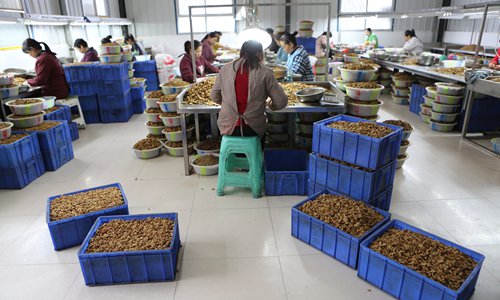
Women work at a local walnut factory in Kangxian county, Longnan, Northwest China's Gansu Province. (Photo: Chen Qingqing/GT)
In the southern part of Longnan of Northwest China's Gansu Province, the Bailong River flows between hills covered with olive trees, serving as a "green belt" for locals. [Special Coverage]
A Huangjiaba villager surnamed Zhang comes to work at a local olive factory a few miles from his home. "I get paid 3,000 yuan ($454.40) every month, and I have planted some olive trees at home, like everybody does here," said the 45-year-old farmer.
A few years ago, Zhang grew wheat on his four mu (0.27 hectares) of land, which only brought him about 800 to 900 yuan each year in revenue. As the region is geographically suited to olives, some households by the river also planted olive trees in the past.
"But when they matured, it was hard to sell them all, and we had to throw a lot of them into the river," the farmer said.
For Zhang, who used to live under the poverty line, it is hard for him to imagine that one day, the olive trees he grows can be processed into various products which can then be presented at a competition in New York.
A local olive factory, Xiangyu, now buys about eight tons of olives from the farmer every October, which are squeezed and processed into olive oil. "I can earn in total about 60,000 yuan per year by selling olives to the factory," the farmer said contentedly.
Since the 18th CPC National Congress, a series of preferential policies such as the distribution of special poverty alleviation fund and targeted staff training have helped local enterprises and villages in Gansu to thrive.
The province's population living below the poverty line has declined from 8.42 million in 2011 to 2.27 million in 2016.
It is just one of numerous examples in China of how poverty alleviation work directed from the top has been taking effect in rural areas.
Local officials said that special poverty alleviation funds and supportive policies from the Party and government have all strengthened their confidence in fighting poverty.
"Industry is key. The local government first helped major enterprises grow, which were later able to play a leading role in creating more jobs and lifting farmers out of poverty," said Liu Zaiyi, an official from Longnan's poverty alleviation office.
Becoming a stakeholder
Today, Zhang is not just a farmer, but also a stakeholder in the local olive industry. "We signed contracts with the factory to make sure that it buys all the olives we plant. There's no waste," he said.
In the past, olive trees had to be thrown away as there were no storage areas to keep them fresh, Ma Tong, an employee at the factory, told the Global Times. Since 2015, the factory has been expanding its production scale and purchased new equipment for processing and conserving the fruit, with the help of local authorities.
"Olives have to be squeezed in the first eight hours, or the 'golden period' in this industry. Before, local villagers did not know about this, which affected the quality of the products," Ma said.
The local enterprise now covers 24,520 households that plant olive trees, of which 1,743 are living below the poverty line.
About two hours' drive from Bailong River, a factory lies hidden in the mountains, where dozens of local women carefully select walnuts. "There is a school nearby, I send my kids to the school next to the factory everyday and come to work in this factory," a worker surnamed Feng told the Global Times.
Raising two children, the 38-year-old Feng lives in Dapu village nearby and plants walnut trees, and the factory also buys about 100 kilograms of nuts from Feng's family every year, which helps increase its household income.
The region, one of the poorest in the province, has been encouraging local agricultural industries such as walnut and olives in the past three years as a means of lifting undeveloped mountainous areas out of poverty. The local government has allocated annual special industry funds of 10 million yuan to help industries develop, according to local poverty alleviation office.
Ongoing battle
Su Yumin, Party chief of Maba village in Kangle county of the Linxia Hui Autonomous Prefecture in the province, said he felt excited about introducing the berry-planting industry into the village.
Though this year is the first time the bushes and vines planted by local villagers will bear red berries, "they can expect more," Su noted.
"I heard that many people in big cities now love berry jam. Maybe we can do that too, in the future," said Su.
Like many other villages and regions in China, Gansu's Linxia and Longnan see poverty alleviation as a battle, and introducing agricultural industries has become one way of winning it.
However, many agricultural industries are small-scale businesses, which have little in the way of risk-prevention systems, an official from the provincial poverty alleviation office, told the Global Times.
In order to achieve a full-scale well-off society by 2020 and lift all poor villages in the province out of poverty, the local government expects more policy support after the 19th CPC Congress, the official noted. "We still need to further improve infrastructure in rural areas, and help some small agricultural businesses to grow," he added.


















































